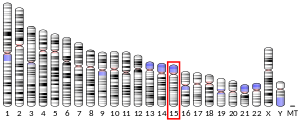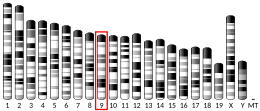PIAS1
PIAS1| PIAS1 | |||||||||||||||||||||||||
|---|---|---|---|---|---|---|---|---|---|---|---|---|---|---|---|---|---|---|---|---|---|---|---|---|---|
 | |||||||||||||||||||||||||
| |||||||||||||||||||||||||
| 식별자 | |||||||||||||||||||||||||
| 에일리어스 | PIAS1, DDXBP1, GBP, GU/RH-II, ZMIZ3, 활성화된 STAT1의 단백질 억제제 | ||||||||||||||||||||||||
| 외부 ID | OMIM: 603566 MGI: 1913125 HomoloGene: 22953 GenCard: PIAS1 | ||||||||||||||||||||||||
| |||||||||||||||||||||||||
| |||||||||||||||||||||||||
| |||||||||||||||||||||||||
| |||||||||||||||||||||||||
| 맞춤법 | |||||||||||||||||||||||||
| 종. | 인간 | 마우스 | |||||||||||||||||||||||
| 엔트레즈 | |||||||||||||||||||||||||
| 앙상블 | |||||||||||||||||||||||||
| 유니프로트 | |||||||||||||||||||||||||
| RefSeq(mRNA) | |||||||||||||||||||||||||
| RefSeq(단백질) | |||||||||||||||||||||||||
| 장소(UCSC) | Chr 15: 68.05 ~68.2 Mb | Chr 9: 62.79 ~62.9 Mb | |||||||||||||||||||||||
| PubMed 검색 | [3] | [4] | |||||||||||||||||||||||
| 위키데이터 | |||||||||||||||||||||||||
| |||||||||||||||||||||||||
E3 SMO-단백질리가수분해효소 PIAS1은 PIAS1 [5][6][7]유전자에 의해 인간에게 코드되는 효소이다.
기능.
이 유전자는 포유동물 PIAS[활성화된 STAT-1(전사-1의 신호 변환기 및 활성화제)의 단백질 억제제] 패밀리의 구성원을 암호화한다.추정 아연 결합 모티브와 고산성 영역을 함유한 부재.STAT1 매개 유전자 활성화 및 DNA 결합 활성을 억제하고, Gu 단백질/RNA 헬리케이스 II/DEAD 박스 폴리펩타이드 21에 결합하며, 안드로겐 수용체(AR)와 상호작용한다.고환에서 핵수용체 전사핵조절기로 기능하며 AR 개시 및 정자 형성의 [7]유지에 역할을 할 수 있다.
상호 작용
PIAS1은 다음과 상호작용하는 것으로 나타났습니다.
레퍼런스
- ^ a b c GRCh38: 앙상블 릴리즈 89: ENSG000033800 - 앙상블, 2017년 5월
- ^ a b c GRCm38: 앙상블 릴리즈 89: ENSMUSG000032405 - 앙상블, 2017년 5월
- ^ "Human PubMed Reference:". National Center for Biotechnology Information, U.S. National Library of Medicine.
- ^ "Mouse PubMed Reference:". National Center for Biotechnology Information, U.S. National Library of Medicine.
- ^ Liu B, Liao J, Rao X, Kushner SA, Chung CD, Chang DD, Shuai K (September 1998). "Inhibition of Stat1-mediated gene activation by PIAS1". Proc Natl Acad Sci U S A. 95 (18): 10626–10631. doi:10.1073/pnas.95.18.10626. PMC 27945. PMID 9724754.
- ^ Valdez BC, Henning D, Perlaky L, Busch RK, Busch H (July 1997). "Cloning and characterization of Gu/RH-II binding protein". Biochem Biophys Res Commun. 234 (2): 335–340. doi:10.1006/bbrc.1997.6642. PMID 9177271.
- ^ a b "Entrez Gene: PIAS1 protein inhibitor of activated STAT, 1".
- ^ Ling Y, Sankpal UT, Robertson AK, McNally JG, Karpova T, Robertson KD (2004). "Modification of de novo DNA methyltransferase 3a (Dnmt3a) by SUMO-1 modulates its interaction with histone deacetylases (HDACs) and its capacity to repress transcription". Nucleic Acids Res. 32 (2): 598–610. doi:10.1093/nar/gkh195. PMC 373322. PMID 14752048.
- ^ a b c Kahyo T, Nishida T, Yasuda H (September 2001). "Involvement of PIAS1 in the sumoylation of tumor suppressor p53". Mol. Cell. 8 (3): 713–8. doi:10.1016/s1097-2765(01)00349-5. PMID 11583632.
- ^ Gallagher WM, Argentini M, Sierra V, Bracco L, Debussche L, Conseiller E (June 1999). "MBP1: a novel mutant p53-specific protein partner with oncogenic properties". Oncogene. 18 (24): 3608–16. doi:10.1038/sj.onc.1202937. PMID 10380882.
- ^ Liao J, Fu Y, Shuai K (May 2000). "Distinct roles of the NH2- and COOH-terminal domains of the protein inhibitor of activated signal transducer and activator of transcription (STAT) 1 (PIAS1) in cytokine-induced PIAS1-Stat1 interaction". Proc. Natl. Acad. Sci. U.S.A. 97 (10): 5267–72. doi:10.1073/pnas.97.10.5267. PMC 25817. PMID 10805787.
- ^ a b Lee BH, Yoshimatsu K, Maeda A, Ochiai K, Morimatsu M, Araki K, Ogino M, Morikawa S, Arikawa J (December 2003). "Association of the nucleocapsid protein of the Seoul and Hantaan hantaviruses with small ubiquitin-like modifier-1-related molecules". Virus Res. 98 (1): 83–91. doi:10.1016/j.virusres.2003.09.001. PMID 14609633.
- ^ a b Sapetschnig A, Rischitor G, Braun H, Doll A, Schergaut M, Melchior F, Suske G (October 2002). "Transcription factor Sp3 is silenced through SUMO modification by PIAS1". EMBO J. 21 (19): 5206–15. doi:10.1093/emboj/cdf510. PMC 129032. PMID 12356736.
추가 정보
- Tan J, Hall SH, Hamil KG, Grossman G, Petrusz P, Liao J, Shuai K, French FS (2000). "Protein inhibitor of activated STAT-1 (signal transducer and activator of transcription-1) is a nuclear receptor coregulator expressed in human testis". Mol. Endocrinol. 14 (1): 14–26. doi:10.1210/mend.14.1.0408. PMID 10628744.
- Liao J, Fu Y, Shuai K (2000). "Distinct roles of the NH2- and COOH-terminal domains of the protein inhibitor of activated signal transducer and activator of transcription (STAT) 1 (PIAS1) in cytokine-induced PIAS1-Stat1 interaction". Proc. Natl. Acad. Sci. U.S.A. 97 (10): 5267–5272. doi:10.1073/pnas.97.10.5267. PMC 25817. PMID 10805787.
- Kotaja N, Aittomäki S, Silvennoinen O, Palvimo JJ, Jänne OA (2001). "ARIP3 (androgen receptor-interacting protein 3) and other PIAS (protein inhibitor of activated STAT) proteins differ in their ability to modulate steroid receptor-dependent transcriptional activation". Mol. Endocrinol. 14 (12): 1986–2000. doi:10.1210/mend.14.12.0569. PMID 11117529.
- Gross M, Liu B, Tan J, French FS, Carey M, Shuai K (2001). "Distinct effects of PIAS proteins on androgen-mediated gene activation in prostate cancer cells". Oncogene. 20 (29): 3880–3887. doi:10.1038/sj.onc.1204489. PMID 11439351.
- Liu B, Shuai K (2001). "Induction of apoptosis by protein inhibitor of activated Stat1 through c-Jun NH2-terminal kinase activation". J. Biol. Chem. 276 (39): 36624–36631. doi:10.1074/jbc.M101085200. PMID 11451946.
- Kahyo T, Nishida T, Yasuda H (2001). "Involvement of PIAS1 in the sumoylation of tumor suppressor p53". Mol. Cell. 8 (3): 713–718. doi:10.1016/S1097-2765(01)00349-5. PMID 11583632.
- Weiskirchen R, Moser M, Weiskirchen S, Erdel M, Dahmen S, Buettner R, Gressner AM (2001). "LIM-domain protein cysteine- and glycine-rich protein 2 (CRP2) is a novel marker of hepatic stellate cells and binding partner of the protein inhibitor of activated STAT1". Biochem. J. 359 (Pt 3): 485–96. doi:10.1042/0264-6021:3590485. PMC 1222169. PMID 11672422.
- Megidish T, Xu JH, Xu CW (2002). "Activation of p53 by protein inhibitor of activated Stat1 (PIAS1)". J. Biol. Chem. 277 (10): 8255–8259. doi:10.1074/jbc.C200001200. PMID 11788578.
- Schmidt D, Müller S (2002). "Members of the PIAS family act as SUMO ligases for c-Jun and p53 and repress p53 activity". Proc. Natl. Acad. Sci. U.S.A. 99 (5): 2872–2877. doi:10.1073/pnas.052559499. PMC 122440. PMID 11867732.
- Tan JA, Hall SH, Hamil KG, Grossman G, Petrusz P, French FS (2002). "Protein inhibitors of activated STAT resemble scaffold attachment factors and function as interacting nuclear receptor coregulators". J. Biol. Chem. 277 (19): 16993–17001. doi:10.1074/jbc.M109217200. PMID 11877418.
- Nishida T, Yasuda H (2003). "PIAS1 and PIASxalpha function as SUMO-E3 ligases toward androgen receptor and repress androgen receptor-dependent transcription". J. Biol. Chem. 277 (44): 41311–41317. doi:10.1074/jbc.M206741200. PMID 12177000.
- Rui HL, Fan E, Zhou HM, Xu Z, Zhang Y, Lin SC (2003). "SUMO-1 modification of the C-terminal KVEKVD of Axin is required for JNK activation but has no effect on Wnt signaling". J. Biol. Chem. 277 (45): 42981–42986. doi:10.1074/jbc.M208099200. PMID 12223491.
- Sapetschnig A, Rischitor G, Braun H, Doll A, Schergaut M, Melchior F, Suske G (2002). "Transcription factor Sp3 is silenced through SUMO modification by PIAS1". EMBO J. 21 (19): 5206–5215. doi:10.1093/emboj/cdf510. PMC 129032. PMID 12356736.
- Miyauchi Y, Yogosawa S, Honda R, Nishida T, Yasuda H (2003). "Sumoylation of Mdm2 by protein inhibitor of activated STAT (PIAS) and RanBP2 enzymes". J. Biol. Chem. 277 (51): 50131–50136. doi:10.1074/jbc.M208319200. PMID 12393906.
- Ungureanu D, Vanhatupa S, Kotaja N, Yang J, Aittomaki S, Jänne OA, Palvimo JJ, Silvennoinen O (2004). "PIAS proteins promote SUMO-1 conjugation to STAT1". Blood. 102 (9): 3311–3313. doi:10.1182/blood-2002-12-3816. PMID 12855578.
- Kadaré G, Toutant M, Formstecher E, Corvol JC, Carnaud M, Boutterin MC, Girault JA (2004). "PIAS1-mediated sumoylation of focal adhesion kinase activates its autophosphorylation". J. Biol. Chem. 278 (48): 47434–47440. doi:10.1074/jbc.M308562200. PMID 14500712.
- Tallec LP, Kirsh O, Lecomte MC, Viengchareun S, Zennaro MC, Dejean A, Lombès M (2004). "Protein inhibitor of activated signal transducer and activator of transcription 1 interacts with the N-terminal domain of mineralocorticoid receptor and represses its transcriptional activity: implication of small ubiquitin-related modifier 1 modification". Mol. Endocrinol. 17 (12): 2529–2542. doi:10.1210/me.2003-0299. PMID 14500761.
- Coppola D, Parikh V, Boulware D, Blanck G (2009). "Substantially reduced expression of PIAS1 is associated with colon cancer development". J Cancer Res Clin Oncol. 135 (9): 1287–91. doi:10.1007/s00432-009-0570-z. PMID 19288270. S2CID 20383429.







